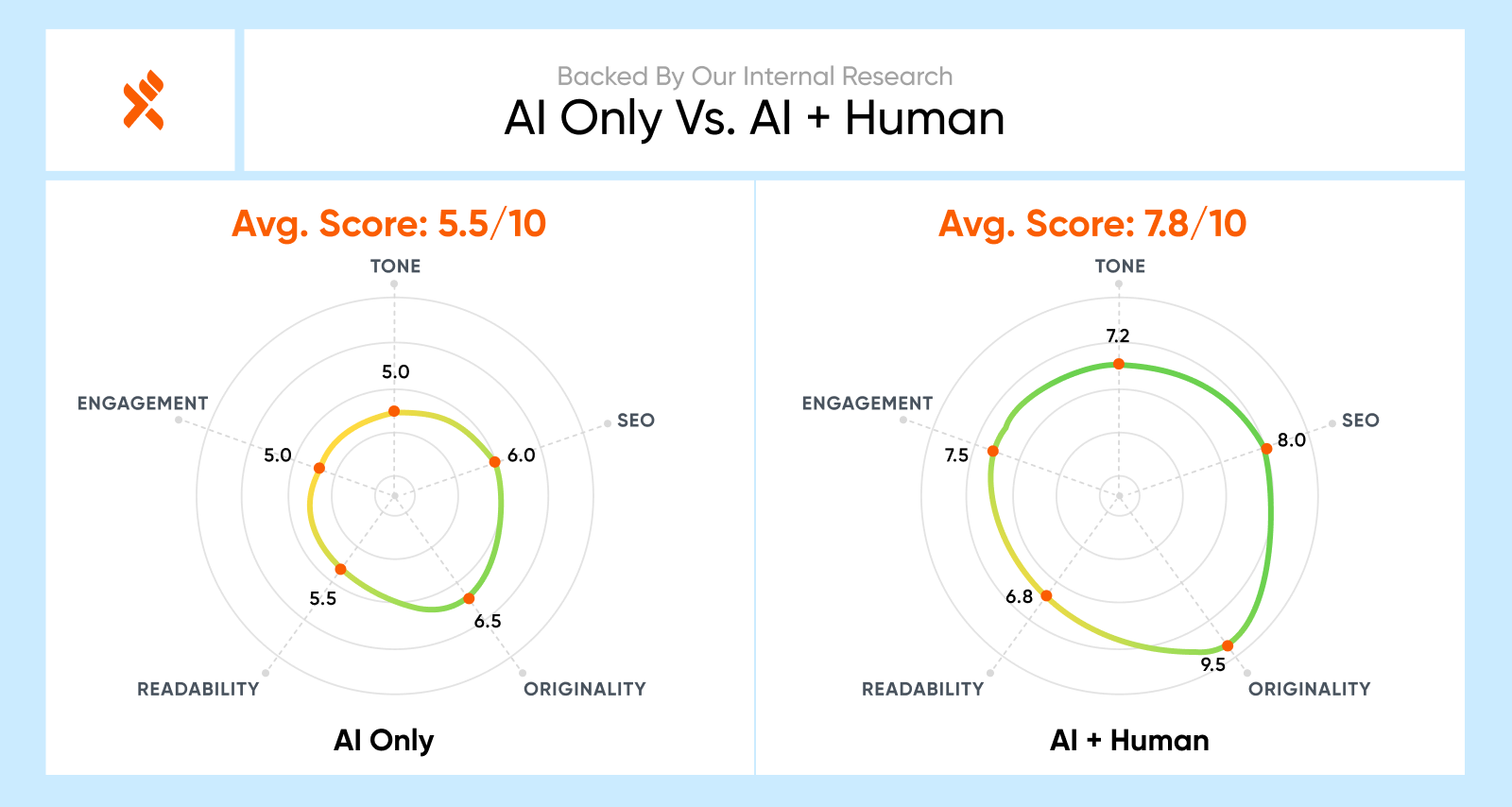Introduction
AI is everywhere in marketing.
But at most organizations, it’s still used like a vending machine—drop in a prompt, get some text, and hope it works.
At Axelerant, we’re doing things differently.
We’re building a strategic, AI + Human content production framework—where AI doesn’t just respond to commands. It acts like a thinking marketer embedded in our workflows. One that collaborates, interviews, ideates, and drafts content alongside humans across every stage of the buyer journey.
We also ran a direct comparison between AI-only content and content created using our AI + Human content production framework.
Same outlines. Same goals. Different outcomes.
We will talk about the breakdown in the following sections.
AI vs. AI + Human: What We Learned from a 10-Blog Test
We tested 10 blogs across two workflows:
- Track A: 100% AI-generated using generic prompts
- Track B: Content created through Axelerant’s AI + Human system
Each blog was scored on:
- Tone of Voice
- Originality
- Readability
- Engagement
- SEO

Despite being faster to generate, AI-only content:
- Lacked brand tone
- Missed contextual relevance
- Was harder to read and less engaging
In contrast, AI + Human content hit the mark with:
- Richer narratives
- Strategic flow
- Real-world language and buyer alignment
"The future of content isn’t human vs. AI. It’s human + AI — inside a framework that works."
- Nathan Roach, Marketing Director
The Shift: From Prompt-Driven Tools to Purpose-Built AI Agents
Most teams using AI fall into the trap of surface-level automation:
- “Write me a blog on X.”
- “Summarize this email.”
- “Turn these bullets into a LinkedIn post.”
These are useful shortcuts, but they’re not strategic.
They don't consider buyer stage, narrative arc, delivery context, or service alignment.
So instead of building one-off prompt hacks, we are trying to architect a system of intelligent AI agents. And at the heart of this framework is a core principle:
“If your AI content still sounds like AI, you’re doing it wrong. Let it think. Let it collaborate. Let it be part of the team.”
- Brahmpreet Singh, Sr. Marketing Manager
That means:
- Brainstorming with stakeholders
- Interviewing Subject Matter Experts
- Understanding services and buyer pain points
- Suggesting angles, not just paragraphs
- Drafting usable content with strategic intent
This framework powers content at scale—without sacrificing depth or clarity.
AI + Human Across the Buyer Journey
Our content system is structured around the buyer journey, and each stage has specific AI agents assigned to support content creation. This isn’t about replacing roles. It’s about enhancing every role involved in content creation.
|
Buyer Journey Stage |
What AI Does |
What Humans Do |
|
Opportunity Stage |
Extracts context, proposes angles, drafts POVs |
Validate direction, edit tone, get interviewed, share context, add proof |
|
Engagement Stage |
Monitors delivery threads, surfaces themes |
Shape messaging, connect to outcomes |
|
Continuous Engagement |
Curates CS wins, drafts newsletters and stories |
Align with brand, personalize for accounts |
Spotlight: Opportunity Stage Content Strategist GPT
One of the best examples of our framework in action is the Opportunity Stage Content Strategist — a custom GPT that supports early-stage sales and marketing collaboration.
This agent lives right where it matters most: at the intersection of solutions consulting and early-funnel storytelling.
How It Works:
1. It starts by asking the right questions.
Rather than jumping into writing, it asks:
- What opportunity is this tied to?
- Who is the buyer persona?
- What are their key blockers?
- Which Axelerant capability are we positioning?
2. It pulls real context.
The GPT pulls structured briefs, Slack threads, or call notes—then:
- Extracts themes
- Identifies emotional and functional pain points
- Maps the opportunity to service buckets like Strategy, Build, Grow, or Delivery
3. It generates smart, usable content.
Depending on the opportunity, it can draft:
- Early-funnel blog posts
- POV articles
- Case study fragments
- Strategic follow-up emails
- Social content
4. It hands off to a human for final polish.
A Marketing Editor steps in to:
- Sharpen the tone of voice
- Strengthen CTA alignment
- Ensure structure and formatting match brand standards
The end result?
Strategic, ready-to-publish content that originated with AI—but feels like it was written by a human who knows the buyer.
Final Thought
AI isn’t just here to stay—it’s evolving fast.
But at Axelerant, we believe the real opportunity lies in how we use it. Not as a shortcut. Not as a replacement. But as a thinking partner that works alongside humans to create smarter, faster, more strategic content.
The future of content isn’t about choosing between AI or humans.
It’s about building the right balance—where AI brings the speed, and humans bring the soul.
That’s where real impact happens.
This agent lives right where it matters most: at the intersection of solutions consulting and early-funnel storytelling.

Brahmpreet Singh, Senior Marketing Manager
Brahmpreet Singh is a marketing professional with over a decade of experience in SaaS and B2B content strategy. He enjoys blending research-driven insights with creative storytelling to support meaningful growth in organic traffic and lead generation. Brahmpreet is dedicated to building thoughtful, data-informed marketing strategies that resonate with audiences and drive long-term success.

 We respect your privacy. Your information is safe.
We respect your privacy. Your information is safe.
Leave us a comment